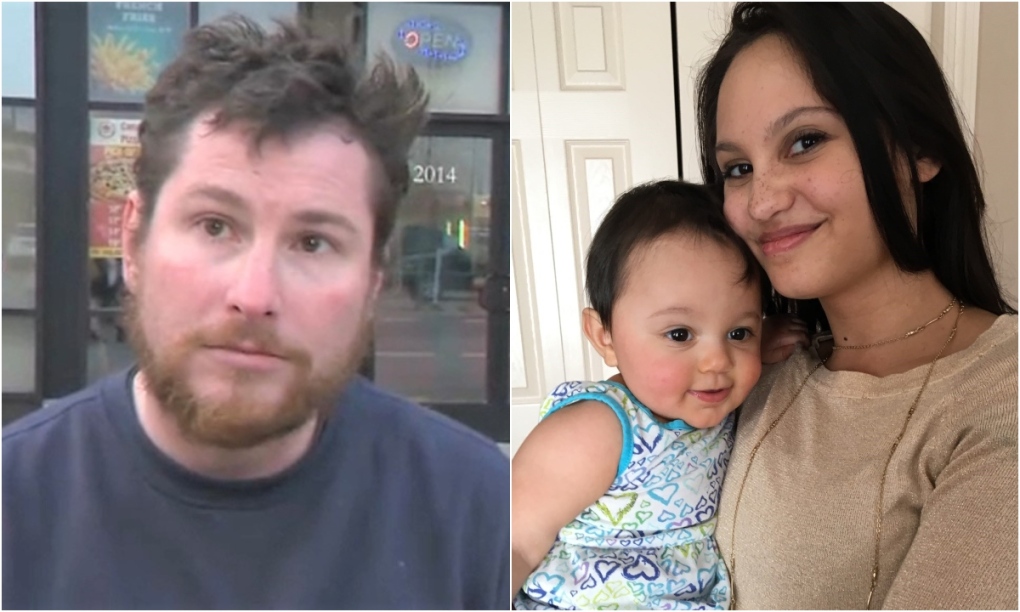Forensic pathologist at Calgary murder trial says it's unlikely toddler Aliyah Sanderson died from a fall
 Robert Leeming (left) was found guilty in the deaths of Jasmine Lovett and Lovett's daughter Aliyah Sanderson (right).
Robert Leeming (left) was found guilty in the deaths of Jasmine Lovett and Lovett's daughter Aliyah Sanderson (right).
A forensic pathologist says it's unlikely a toddler, found buried with her mother west of Calgary two years ago, died as a result of an accidental fall.
Deputy medical examiner Dr. Akmal Coetzee-Khan returned to the witness stand Wednesday at the trial of Robert Leeming.
Leeming, a 36-year-old British citizen, has pleaded guilty to second-degree murder in the death of his girlfriend, Jasmine Lovett, but not guilty to second-degree murder in the death of 22-month-old Aliyah Sanderson.
Lovett and her daughter were reported missing in April 2019. The next month, police found their bodies in a shallow grave at a day-use area in Kananaskis Country, west of Calgary.
Leeming told police at the time that he and Lovett had been in a relationship after meeting online in 2018. She and her daughter moved in with him a month later.
Coetzee-Khan testified earlier at the trial that Aliyah died of blunt force injuries to her head while Lovett suffered three skull fractures and was shot in the head.
On Tuesday, the doctor was asked if the child's head and face injuries could be explained by a fall.
"It's not impossible to have blunt force traumatic injuries from a single fall. It would be very unlikely,'' said Coetzee-Khan.
He noted that if the girl had fallen forward, there should have been injuries to her arms. And if she had fallen backward, there should have been injuries to her buttocks.
"On Aliyah, we don't see any of those types of injuries ... so it doesn't seem like there was a fall where her arms and legs were involved in the process.''
During cross-examination, Leeming's lawyer, Balfour Der, suggested Aliyah's injuries could have been explained by a simple fall down some stairs.
"Could a tumble down stairs _ plural, not just a single fall _ cause these brain injuries and abrasions that you saw?'' Der asked.
"Yes, it could cause the head injuries if we're only talking about that ... not taking into account the rest of the body,'' Coetzee-Khan replied.
"If we're talking about a tumble down the stairs, one would expect to see bruising or abrasions against the same surface to your arms and legs.''
Coetzee-Khan said he ruled Aliyah's death a homicide for three reasons: her injuries, where her body was found and because nobody called 911 to get her help.
Der said there could be an "innocent explanation'' as to why someone wouldn't call 911. He added there are a lot of unanswered questions in the girl's death.
"You cannot tell this court how these injuries to Aliyah Sanderson were caused. You can't eliminate a fall versus being thrown against a wall, for example?'' Der said.
"I can't eliminate them,'' said Coetzee-Khan.
"I didn't think so. Thank you doctor,'' Der said.
CTVNews.ca Top Stories

Former soldier 'Canadian Dave' taken by the Taliban: sources
David Lavery, a former Canadian Forces soldier who helped approximately 100 people flee Afghanistan during the fall of Kabul, has been 'picked up' by the Taliban this week, according to multiple sources who spoke to CTV National News on the condition of anonymity.
Canada Revenue Agency eliminating nearly 600 term positions by end of 2024
The Canada Revenue Agency will be eliminating approximately 600 temporary and contract employees across the country by mid-December.
Montreal road rage caught on video: Suspect charged with assault causing bodily harm
A 47-year-old Terrebonne man has been charged following a case of road rage in broad daylight last summer on the Ile-aux-Tourtes bridge.
Alta. Premier Danielle Smith will be in Washington for Trump inauguration
Alberta Premier Danielle Smith will be heading to Washington, D.C., for Donald Trump's presidential inauguration.
WestJet passengers can submit claims now in $12.5M class-action case over baggage fees
Some travellers who checked baggage on certain WestJet flights between 2014 and 2019 may now claim their share of a class-action settlement approved by the British Columbia Supreme Court last month and valued at $12.5 million.
Trump names Karoline Leavitt as youngest ever White House press secretary
U.S. President-elect Donald Trump on Friday named Karoline Leavitt, his campaign press secretary, to serve as his White House press secretary.
Mike Tyson vs. Jake Paul: How to watch the fight, what time and who's the favourite?
YouTuber-turned-boxer Jake Paul had to wait an extra four months for his high-profile match with 58-year-old former heavyweight champion Mike Tyson, but fight night has arrived.
Iranian official met with Musk in a possible step to ease tensions with Trump
Iran successfully sought a meeting with Elon Musk, according to a U.S. official, one in a series of steps that appeared aimed at easing tensions with President-elect Donald Trump.

































